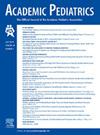Sexual Identity Is Associated With Adverse Childhood Experiences in US Early Adolescents
IF 3
3区 医学
Q1 PEDIATRICS
引用次数: 0
Abstract
Objective
To determine disparities in adverse childhood experiences (ACEs) by sexual identity in a national cohort of early adolescents.
Methods
We analyzed cross-sectional data from year 2 of the Adolescent Brain Cognitive Development study (N = 10,934, 2018–20, ages 10–14 years). Disparities in ACE scores across lesbian, gay, or bisexual (LGB), not sure, and heterosexual adolescents were assessed using multinomial logistic regression analyses. Logistic regressions estimated the associations between sexual identity and each individual ACE. Analyses were adjusted for potential confounders.
Results
In adjusted models, LGB adolescents had a higher risk of experiencing 2, 3, or ≥4 ACEs (relative risk ratios [RRR] = 1.57, 95% Confidence Interval (CI) 1.01–2.42), 3 (RR = 1.78, 95% CI 1.100–2.88), or ≥4 ACEs (RRR = 3.20, 95% CI 1.92–5.32), and not sure adolescents had a higher risk of having ≥4 ACEs (RRR = 2.17, 95% CI 1.22–3.87), compared to heterosexual adolescents. LGB and not sure adolescents had higher risks of reporting emotional abuse (“yes” OR = 4.21, 95% CI 1.84–9.61; “maybe” OR = 6.20, 95% CI 2.91–13.19) and parent mental illness (“yes” OR = 1.95, 95% CI 1.48–2.57; “maybe” OR = 1.63, 95% CI 1.21–2.18) compared to heterosexual adolescents.
Conclusions
LGB adolescents and those questioning their sexual identity were at greater risk of having higher ACE scores, with LGB adolescents experiencing the highest risk of experiencing ACEs. LGB adolescents also had higher odds of reporting emotional and parent mental illness. Recognizing this heightened risk of ACEs in early adolescence is critical for designing clinic and school-based interventions.
美国早期青少年的性别认同与童年不良经历(ACEs)有关。
目的确定全国早期青少年队列中不同性别身份的儿童不良经历(ACE)的差异:我们分析了青少年大脑认知发展研究第二年的横截面数据(N=10934,2018-2020 年,10-14 岁)。我们使用多项式逻辑回归分析评估了女同性恋、男同性恋或双性恋(LGB)青少年、不确定青少年和异性恋青少年之间 ACE 分数的差异。逻辑回归估算了性身份与每个个体 ACE 之间的关联。分析对潜在的混杂因素进行了调整:在调整后的模型中,LGB 青少年经历 2、3 或≥4 个 ACE 的风险较高(相对风险比 [RRR] =1.57,95% CI 1.01-2.42),经历 3 个 ACE 的风险较高(RR=1.78,95% CI 1.100-2.88),经历≥4 个 ACE 的风险较高(相对风险比 [RRR] =1.57,95% CI 1.01-2.42)。与异性恋青少年相比,男女同性恋、双性恋和变性青少年以及不确定青少年发生≥4次ACE的风险更高(RRR=2.17,95% CI 1.22-3.87)。与异性恋青少年相比,男女同性恋、双性恋和变性青少年以及不确定青少年报告情感虐待("是 "OR=4.21,95% CI 1.84-9.61;"可能 "OR=6.20,95% CI 2.91-13.19)和父母患有精神疾病("是 "OR=1.95,95% CI 1.48-2.57;"可能 "OR=1.63,95% CI 1.21-2.18)的风险更高:结论:男女同性恋、双性恋和变性青少年以及那些对自己的性身份有疑问的青少年有更高的 ACE 评分风险,其中男女同性恋、双性恋和变性青少年经历 ACE 的风险最高。此外,LGB 青少年报告患有情绪病和父母精神疾病的几率也更高。认识到青春期早期发生 ACE 的高风险对于设计诊所和学校的干预措施至关重要。
本文章由计算机程序翻译,如有差异,请以英文原文为准。
求助全文
约1分钟内获得全文
求助全文
来源期刊

Academic Pediatrics
PEDIATRICS-
CiteScore
4.60
自引率
12.90%
发文量
300
审稿时长
60 days
期刊介绍:
Academic Pediatrics, the official journal of the Academic Pediatric Association, is a peer-reviewed publication whose purpose is to strengthen the research and educational base of academic general pediatrics. The journal provides leadership in pediatric education, research, patient care and advocacy. Content areas include pediatric education, emergency medicine, injury, abuse, behavioral pediatrics, holistic medicine, child health services and health policy,and the environment. The journal provides an active forum for the presentation of pediatric educational research in diverse settings, involving medical students, residents, fellows, and practicing professionals. The journal also emphasizes important research relating to the quality of child health care, health care policy, and the organization of child health services. It also includes systematic reviews of primary care interventions and important methodologic papers to aid research in child health and education.
 求助内容:
求助内容: 应助结果提醒方式:
应助结果提醒方式:


